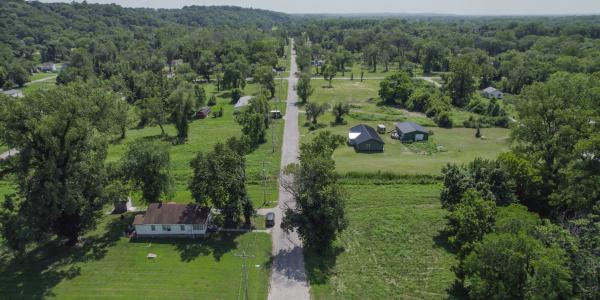An interdisciplinary team of WashU researchers are using anthropology, microbiology, hydrology, data science, and environmental engineering to address the health impacts of chronic flooding in Cahokia Heights, Illinois.
Cornelius Bennett’s home in Cahokia Heights, Illinois, should have been a great place for him to enjoy a quiet retirement. He lives in a leafy, low-lying neighborhood just north of Highway 157 and east of Grand Marais Lake. The houses here are widely spaced, but he can still hear his neighbor’s chickens clucking from his front porch. He set up a swing set in his side yard, but there are plenty of days when he won’t let his grandchildren go outside to play.

Bennett’s house and yard get swamped with a toxic mixture of rainwater and raw sewage after just a mild rain. The aging sewer system is easily overwhelmed, and wastewater escapes pipes and gutters to invade homes and neighborhoods. “Sewage water goes straight into the ditch right next to my house,” Bennett said. “I’ve got raw sewage in my backyard. It’s happening all over the neighborhood.”

Bennett, a plaintiff in a 2020 lawsuit against the city, is not alone in his troubles, and he’s not alone in his fight to make Cahokia Heights a cleaner, healthier place to live. Less than 20 miles away on the other side of the Mississippi, a team of WashU researchers — including anthropologist Theresa Gildner; biologist Liz Mallott; geoscientist Claire Masteller; and engineer Fangqiong Ling — is working to document and explain the public health disaster unfolding in the Metro East area.
In 2023, Gildner, Mallott, and Masteller received a seed grant from Arts & Sciences’ Transdisciplinary Institute in Applied Data Sciences to study the intertwined threats of floods and communicable diseases in Cahokia Heights. The team noted that already recurring flooding will likely become more common in other small communities as the climate changes. Cahokia Heights isn’t just a town in crisis; it’s a warning for other places with subpar sewage and drainage systems.

Their work is already having a positive impact, thanks to collaboration and support from Equity Legal Services, a local non-profit legal service that represents many of the community members impacted by flooding, and Centreville Citizens for Change, a community nonprofit that has been advocating for changes to the city’s infrastructure through litigation and letters to elected officials since 2018. The findings from Gildner and her team helped inspire local and state governments to allocate $30 million on upgrades to the sewer systems. “The WashU team has really built a partnership with us,” said Nicole Nelson, an attorney with Equity Legal Services. “They’ve been lifesavers.”
Dangerous water
Documenting the health risks faced by residents has been a top priority for the WashU team. Fecal tests conducted by Gildner, an assistant professor of anthropology, showed clear signs of parasitic and bacterial infections in Cahokia Heights residents. One of the bacterial pathogens, H. pylori, can cause ulcers and raise the risk of cancer. The study also documented high levels of intestinal inflammation, a clear sign that contamination was taking a toll. “We were able to show the connection between reported flooding and poor intestinal health,” Gildner said. “The next step is to look for similar connections using objective flooding data.”

A city on the outskirts of St. Louis may seem like an unexpected setting for an anthropologist, but Gildner has long been interested in the ways environmental threats can shape people’s daily lives. She has spent years studying parasitic infections in a tribe in the Ecuadorian Amazon, an experience that left her well-prepared to work with communities along the world’s great rivers, including the Mississippi. “When people think about parasitic diseases, they often picture places like Ecuador, but these problems are becoming increasingly common in the U.S.,” she said. “They’re diseases of poverty.”
After arriving at WashU in 2021, Gildner studied the health impacts of flooding in the rural Mississippi Delta. During a class, a graduate student mentioned that nearby communities in Illinois were facing similar problems. “I started gathering news articles about Centreville and Cahokia Heights,” she said. “When I realized the magnitude of the problem, I reached out to Centreville Citizens for Change and Equity Legal Services to see if I could help.”

Yvette Lyles, a retired psychiatric nurse, has endured regular flooding at her brick home in Cahokia Heights since she bought it more than 30 years ago. “Thank God Theresa and the others came to do testing,” Lyles said. “It’s inhumane to make us live like this over and over again. We need all the support we can get.”
For Lyles, help can’t come quickly enough. “As soon as it rains, you see the storm water coming down the street,” she said. “A hot second later, the raw sewage starts bubbling up. It not only destroys our home, it destroys our health.” Lyles said she has had multiple infections of H. pylori even though she tries to take every precaution, including treating her lawn with disinfecting chemicals and throwing away wet clothes and even pieces of furniture after her house floods. “I buy clothes at Goodwill now,” she said. “What’s the point of buying new clothes when you’ll just have to throw them away?”
A team approach
Addressing the public health disaster unfolding in Cahokia Heights and other Metro East towns required the kind of scientific collaboration that’s become a hallmark of WashU research. Gildner recruited Liz Mallott, an assistant professor of biology, to join the cause. Mallott studies how exposure to floodwater can shape a person’s microbiome, the trillions of gut bacteria that play a crucial role in health and disease. “Changes in microbiomes are associated with many health conditions, including diabetes, cancer, and autoimmune diseases,” Mallott said. “The gut communities are also very sensitive to their environment, including pollutants and outside pathogens.”

By studying fecal samples provided by residents, Mallott has shown that people living in the most flood-prone areas of Cahokia Heights have less healthy microbiomes than their neighbors in drier areas just a few blocks away. “The microbiomes of people who experience more frequent or severe flooding are much less diverse, which is troubling,” she said. Mallott is now taking soil samples across Cahokia Heights to identify bacteria and other contaminants that might explain why floodwater is so harmful to human gut health.
Mallott feels a deep connection to the residents of Cahokia Heights. “I grew up in Appalachia, another part of the country that has been long neglected,” she said. “These people are our neighbors, and if I can do something to improve their quality of life, I’m happy to do that.”
In addition to their studies, Mallott and Gildner have shown residents how to use at-home testing kits to check for contaminants in their water. “A lot of folks in Cahokia are really concerned about their tap water, and we've heard a lot of anecdotal stories about people getting sick or developing skin rashes or even burns,” Gildner said. “Most people use bottled water, but they still have to use their tap water for showering.”
“Thank God Theresa and the others came to do testing... We need all the support we can get.” —Yvette Lyles, resident
The team has taken swabs from local sinks and sent them to Fangqiong Ling, an assistant professor of energy, environmental and chemical engineering in McKelvey and an expert in microbial biofilms and water system safety. Ling’s lab is still working to see what germs might be lurking in the water supply. “It’s another way to see how people might be exposed to pathogens after the flooding,” Gildner said.
Flooding is the essential problem in Cahokia Heights, so it’s fitting that Claire Masteller, an assistant professor of Earth, environmental and planetary sciences, is a part of the team. Before Gildner, Mallott, or Ling had ever set their sights on the biological threats of Cahokia Heights, Masteller received a 2022 NASA grant to study the flood risks block by block, neighborhood by neighborhood. Her work made it possible for the rest of the team to identify specific places most likely to be contaminated by sewage.

The work is far from over. In August, the team was awarded a new $3.6 million grant from the National Science Foundation to expand their research to better detail the links between climate, flooding, and human health. They will also add another collaborator: Bo Li, the Stanley A. Sawyer Professor of Statistics & Data Science and a leading expert in the data of rainfall, flooding, and other aspects of climate. Li will use her statistical knowledge to help predict future flooding hazards and estimate the benefits of any upgrades to the infrastructure.
WashU researchers have drawn attention to the problem, but the flooding persists. Even on a dry day, the signs are inescapable: a sinkhole at the end of a driveway, a crumbling roadway, a waterline on a garage door, and the faint, sour smell of ammonia.
The neglect that led to the crisis in the first place also continues. As reported by KTVI, the federal budget passed by Congress in March 2025 left out some $67 million for infrastructure projects in Illinois, including more than $1 million that had already been allocated to address sewage problems in Cahokia Heights.
Until the wastewater is brought under control, WashU researchers will continue to work with the community, and residents will continue to share their stories. “The people in Cahokia are very organized, and they’re open about their problems,” Gildner said. “They’ve been working tirelessly to advocate for change. I’m glad we can do our part to help.”





